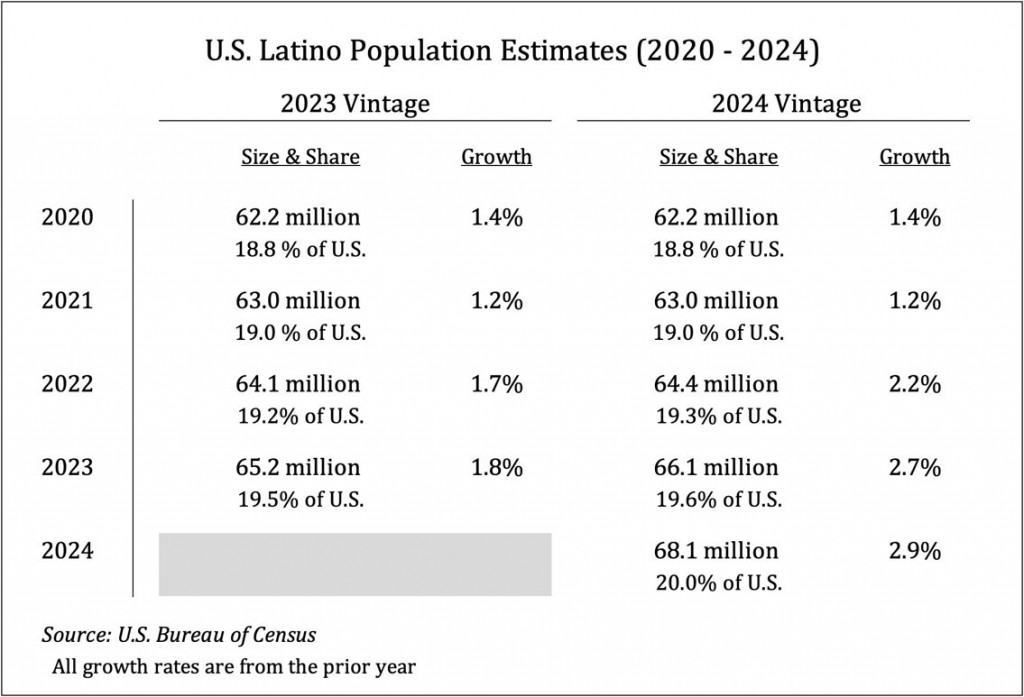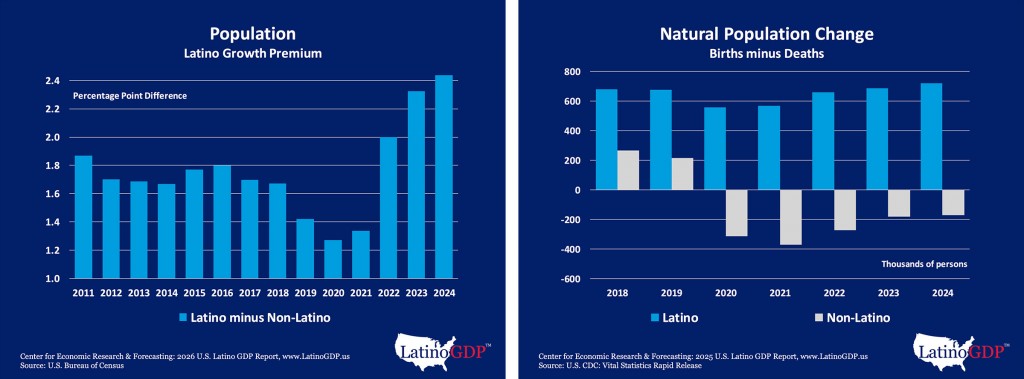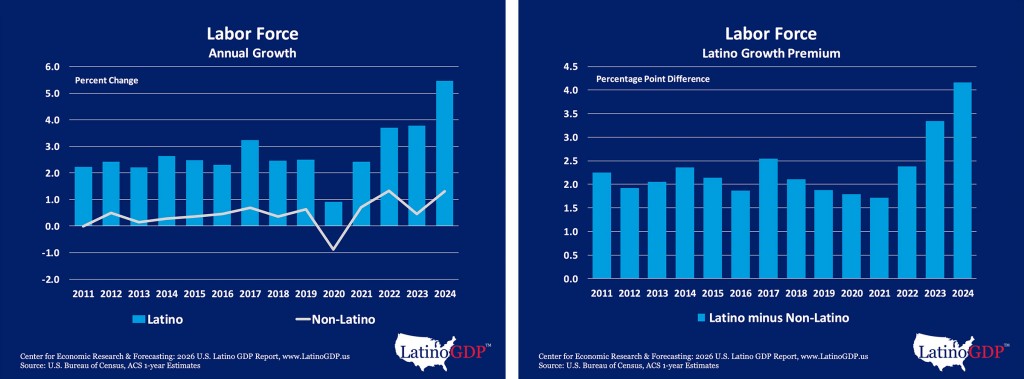CERF Blog
Dan Hamilton, Matthew Fienup, David Hayes-Bautista, Paul Hsu
Introduction
The April release of the 2025 U.S. Latino GDP Report revealed that the U.S. Latino GDP surged past $4 trillion for the first time. At $4.1 trillion, the 2023 U.S. Latino GDP is the world’s fifth largest GDP, larger than the entire economy of India. The U.S. Latino GDP is also the single fastest growing among major economies, growing faster than China’s GDP since 2019 (Hamilton et al, 2025).
Against that already impressive backdrop, we note newly released and record-setting population and labor force data. For the first time in history, one of every five people living in the United States is Latino. In 2024, the Latino labor force grew 5.5 percent, the single strongest growth on record and 4.2 percentage points stronger than Non-Latino. From 2010 to 2024, the Latino component of the U.S. labor force grew 7.2 times faster than the Non-Latino labor force. And the Latino labor force participation rate sits at an all-time high of 69 percent. The Latino labor force participation premium, that is, the difference between Latino and Non-Latino participation rates, hit a record in 2024 of 6.2 percentage points.
The Latino GDP Project, a multi-disciplinary initiative conducted by researchers at California Lutheran University and UCLA, provides careful, explicit, and timely documentation of the economic powerhouse represented by U.S. Latinos. Eight consecutive annual reports document the fact that Latinos living in the United States enjoy substantial economic premiums across a wide range of indicators, relative to Non-Latinos. Latino participation in the U.S. economy is more active and more intense than Non-Latino participation. Further, the vitality of the overall U.S. economy depends on the intensity of activity of U.S. Latinos.
Population
The Census Bureau’s new official population estimates by ethnicity indicate that the size and growth of the Latino cohort are even more auspicious than previously understood. The 2025 U.S. Latino GDP Report, released in April, documented that U.S. Latino population growth accelerated from 1.2 percent in 2020 to 1.8 percent in 2023. The revised estimates still show 1.2 percent in 2020, but 2023 growth is now estimated to be a much more rapid 2.7 percent. The previously estimated 2023 Latino population of 65.2 million has been revised upward to 66.1 million, or 923 thousand more Latinos than previously estimated. (See Table 1.)
The Census Bureau’s June data release also provides new, never-before released data for 2024. The Latino cohort is now, for the first time in history, one out of every five persons in the United States. The United States Latino population as of July 1, 2024 is estimated to be over 68 million, about 2 million persons greater than updated 2023 estimates. Their 2023 to 2024 population growth rate of 2.9 percent is 5.8 times as fast as the growth of the Non-Latino population. The Latino population growth premium, the difference between Latino and Non-Latino one-year growth rates, is 2.4 percentage points in 2024, a historical high. (See Figure 1)
Table 1: Official U.S. Latino Population Estimates
The sources of population growth, and how these vary by ethnicity, are also noteworthy. Latino natural population change (births minus deaths) remained positive throughout the Pandemic, despite Latinos suffering significantly higher Covid-related mortality. From 2020 through 2024, the cumulative Latino natural population increase was an estimated 3.2 million persons, compared to a decline of 1.3 million for Non-Latinos. (See Figure 2) This is an extraordinary 4.5 million person difference.
Figure 1: Latino Population Growth Premium Figure 2: U.S. Natural Population Change
Latinos powered through the extraordinary challenges of the pandemic and were responsible for keeping overall U.S. natural population change positive. This is further evidence that, as noted in previous Latino GDP Reports, Latinos held up the U.S. economy during the pandemic, highlighting just how vital and uplifting Latino strength and resilience are for the nation.
Labor Force
The latest American Community Survey (ACS) labor force data was released in early September and provides new, never-before released data for 2024 labor market effort by U.S. Latinos. The new data show that there were 35.1 million Latinos in the U.S. labor force in 2024, up 46.5 percent since 2010. This compares to a 6.4 percent rise for Non-Latinos, which implies that the Latino labor force grew 7.2 times faster than Non-Latino from 2010 to 2024. While that is a blistering pace of growth spanning more than a decade, the 2024 Latino labor market data sets whole new performance standards. The U.S. Latino labor force participation rate achieved 69 percent, the highest recorded since 2010, and compares to a Non-Latino rate of just 62.8 percent. The Latino labor force participation premium climbed to 6.2 percentage points, an all-time high.
Latino labor force growth is the single most impressive characteristic described in this essay and one of the most impressive in the Latino GDP Project’s entire body of research. The 2024 Latino labor force grew 5.5 percent from 2023. (See Figure 3) This is historic growth and represents an explosion from the 3.8 percent growth of the prior year, where that rate had been the strongest on record. Due to this incredibly rapid growth rate, the 2024 U.S. Latino labor force growth premium, the difference between Latino and Non-Latino labor force growth rates, shattered the historical record at 4.2 percentage points. (See Figure 4) To put this in perspective, from 2011 to 2023, the average Latino labor force growth premium was 2.2 percentage points. At 4.2 percentage points, 2024’s growth premium is more than 90 percent greater than that historical average. This performance is an outlier of strength, even for Latinos, who had already demonstrated impressive and consistent economic strength during the 2010 to 2023 period.
Figure 3: U.S. Labor Force Growth Figure 4: Latino Labor Force Growth Premium
Conclusion
The hard-working, self-sufficient, optimistic U.S. Latino cohort is growing in every way, in absolute numbers, and in shares of the U.S. population and labor force. New data reveal a U.S. Latino population that is historically large and growing yet faster. And, new data indicate that the U.S. Latino labor force is not only larger and growing faster but is shattering records for economic vibrancy. We see a bright future for the United States, because of Latinos. Hard work, self- sufficiency, optimism, perseverance – these are the characteristics that underly the strength and resilience of U.S. Latinos. These same characteristics will continue to drive growth in the overall United States economy for years to come.
References
Hamilton, D., M. Fienup, D. Hayes-Bautista, and P. Hsu. 2025. “2025 U.S. Latino GDP Report: Hard- Working, Self-Sufficient, Optimistic.” Community Partners, April 2025. www.LatinoGDP.us





